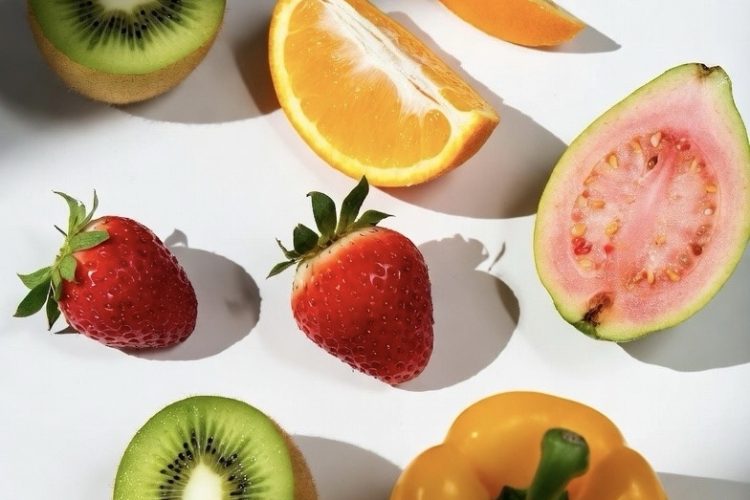Vitamin C (ascorbic acid) boosts immunity, fights oxidative stress, and aids collagen and iron absorption. Your body absorbs 70-90% at low doses (30-180 mg) via SVCT1 transporters, but efficiency drops above 1g. For fast, natural uptake, eat whole foods like kakadu plum, acerola cherry, camu camu, amla, rosehip, guava, yellow peppers, kiwi, or strawberries—these pack bioflavonoids and quercetin that enhance retention. Pair with iron-rich meals to boost both. Steam or eat raw to preserve content. Liposomal or buffered supplements improve absorption; avoid megadoses to prevent diarrhea or kidney stones. Smokers need +35 mg daily. Deficiency causes scurvy; excess risks side effects. Stick to 75-90 mg daily, up to 120 mg if pregnant. Choose food first, supplement smartly.
Long Version
Enhancing Vitamin C Absorption: Fast and Natural Strategies
Vitamin C, also known as ascorbic acid, stands as a cornerstone nutrient essential for bolstering the immune system, acting as a potent antioxidant, and supporting collagen synthesis, which is vital for skin, blood vessels, and connective tissues. Its health benefits extend to wound healing, iron absorption enhancement, and potentially reducing oxidative stress linked to chronic diseases. However, achieving optimal bioavailability—the extent to which the body can utilize this nutrient—depends on efficient absorption mechanisms. This article delves into the science of vitamin C absorption, exploring ways to maximize it quickly and naturally through food sources, strategic pairings, and informed supplement choices, while addressing deficiency risks, side effects, and interactions.
Understanding the Absorption Mechanisms
The body’s uptake of vitamin C involves sophisticated pharmacokinetics, beginning in the intestines where ascorbic acid is primarily absorbed via active transport through the SVCT1 transporter, a sodium-dependent mechanism that saturates at higher doses. At lower concentrations, this active process ensures high efficiency, absorbing 70-90% of intake, but passive diffusion kicks in for dehydroascorbic acid (DHA), the oxidized form, which enters cells via GLUT1 and GLUT3 transporters before being reduced back to ascorbic acid. Tissue transport distributes vitamin C to high-demand areas like leukocytes, eyes, and the brain, maintaining millimolar concentrations intracellularly, while plasma concentration hovers at micromolar levels. Renal reabsorption prevents excessive loss by reclaiming filtered vitamin C through SVCT transporters in the kidneys, but at doses exceeding 1 gram daily, absorption drops below 50%, with unmetabolized excess excreted. Efflux mechanisms, including volume-sensitive anion channels, regulate cellular export to maintain balance, preventing overload. These processes underscore why strategic intake can accelerate absorption, particularly when plasma levels are low. Additionally, factors like gut pH and the presence of other nutrients can modulate transporter activity, with slightly acidic environments potentially aiding initial uptake.
Factors Influencing Bioavailability
Bioavailability of vitamin C is dose-dependent and status-specific; moderate intakes of 30-180 mg daily yield near-complete absorption, while higher amounts face saturation. Interactions play a key role—glucose competes with DHA for GLUT transporters, potentially reducing uptake, and smoking increases requirements by 35 mg daily due to oxidative stress. Natural enhancers like bioflavonoids, including quercetin and citrus bioflavonoids, stabilize vitamin C and boost its retention, while phospholipids in certain foods aid membrane crossing for faster tissue transport. Cooking methods matter: steaming or microwaving preserves more vitamin C than boiling, as it’s water-soluble and heat-sensitive. For rapid absorption, consuming vitamin C with meals enhances iron absorption from plant sources, creating a synergistic effect that amplifies overall nutrient uptake. Lifestyle factors, such as stress or illness, can deplete stores faster, necessitating more frequent intake, and hydration supports renal handling to optimize reabsorption.
Optimal Natural Sources for Fast Absorption
Prioritizing natural sources ensures high bioavailability, as ascorbic acid from foods matches that of synthetic vitamin C but comes bundled with supportive compounds. Kakadu plums top the list, offering up to 2,907 mg per 100 grams, with one plum delivering 350-480 mg—ideal for quick plasma boosts due to their concentrated form. Acerola cherry provides 1,650 mg per half-cup, enhanced by bioflavonoids for superior retention. Camu camu, though less common, boasts similar potency, often used in powders for fast dissolution. Amla (Indian gooseberry) excels in iron absorption synergy, increasing bioavailability when paired with meals. Rosehip delivers 426 mg per 100 grams, rich in antioxidants that protect against degradation. Other standout food sources include guavas (125 mg per fruit), sweet yellow peppers (342 mg per large pepper), blackcurrants (102 mg per half-cup), kiwis (56 mg per medium fruit), broccoli (51 mg per half-cup cooked), Brussels sprouts (48 mg per half-cup cooked), strawberries (97 mg per cup), and oranges (83 mg per medium). These whole-food options outperform isolated supplements in natural synergy, with raw or minimally cooked forms maximizing intake—eat peppers raw or steam broccoli briefly for peak absorption. To further enhance, incorporate diverse sources daily, such as blending camu camu into smoothies or adding amla to teas, ensuring steady plasma levels without spikes.
Supplements: Bridging Gaps with Advanced Forms
When diet falls short, supplements offer targeted support. Synthetic vitamin C mirrors natural bioavailability but lacks cofactors. Whole-food supplements, derived from acerola cherry or amla, incorporate bioflavonoids for enhanced tissue transport. Buffered vitamin C, often as calcium ascorbate, reduces acidity for gentler digestion, ideal for sensitive stomachs. For fastest absorption, liposomal vitamin C uses liposomal encapsulation—wrapping ascorbic acid in phospholipids—to bypass intestinal limits, achieving higher plasma concentrations than standard forms. Intravenous administration delivers 100% bioavailability directly into the bloodstream, used clinically for severe deficiencies but not for routine use. Dosage guidelines recommend 75-90 mg daily for adults, up to 120 mg during pregnancy, with smokers needing extra; exceed 2,000 mg at risk of side effects. Time-released formulations can provide sustained release, mimicking multiple small doses to maintain steady levels and improve overall utilization over time.
Risks of Deficiency and Overconsumption
Vitamin C deficiency manifests as scurvy, with symptoms like fatigue, gum inflammation, joint pain, and poor wound healing emerging after weeks of intake below 10 mg daily. Rare in developed nations, it affects those with limited fruit and vegetable access. Side effects from excess include diarrhea, nausea, and abdominal cramps due to osmotic effects, plus potential kidney stones from elevated oxalate. Interactions warrant caution: high doses may interfere with chemotherapy, statins, or warfarin, while boosting aluminum or estrogen levels. In hemochromatosis, avoid excess to prevent iron overload. Monitoring intake through blood tests can help tailor needs, especially for at-risk groups like the elderly or those with malabsorption issues.
Maximizing Benefits Through Informed Choices
By leveraging natural sources rich in bioflavonoids and quercetin, pairing with iron-rich foods, and selecting advanced supplements like liposomal forms when needed, you can achieve fast, efficient vitamin C absorption. This approach not only supports immune function and antioxidant defense but also prevents deficiency without unnecessary risks. Consult healthcare providers for personalized dosage, especially with interactions or high needs, to harness vitamin C’s full potential as a daily health ally. Emerging research suggests potential roles in cognitive health and exercise recovery, further emphasizing balanced, natural strategies for long-term wellness.







